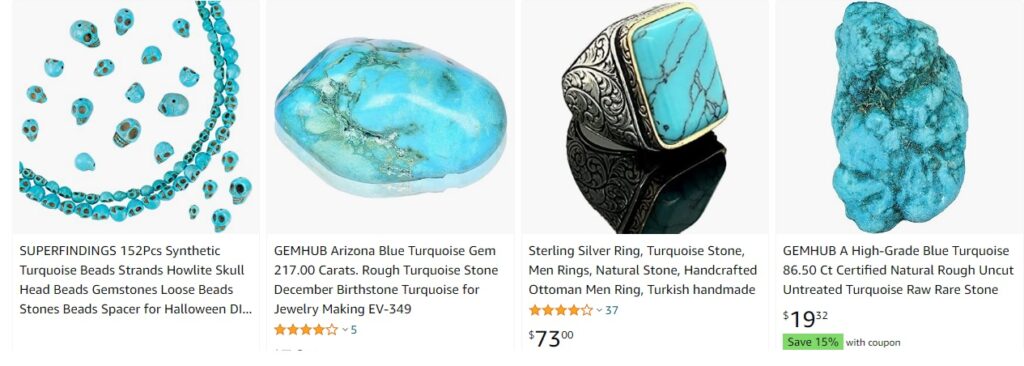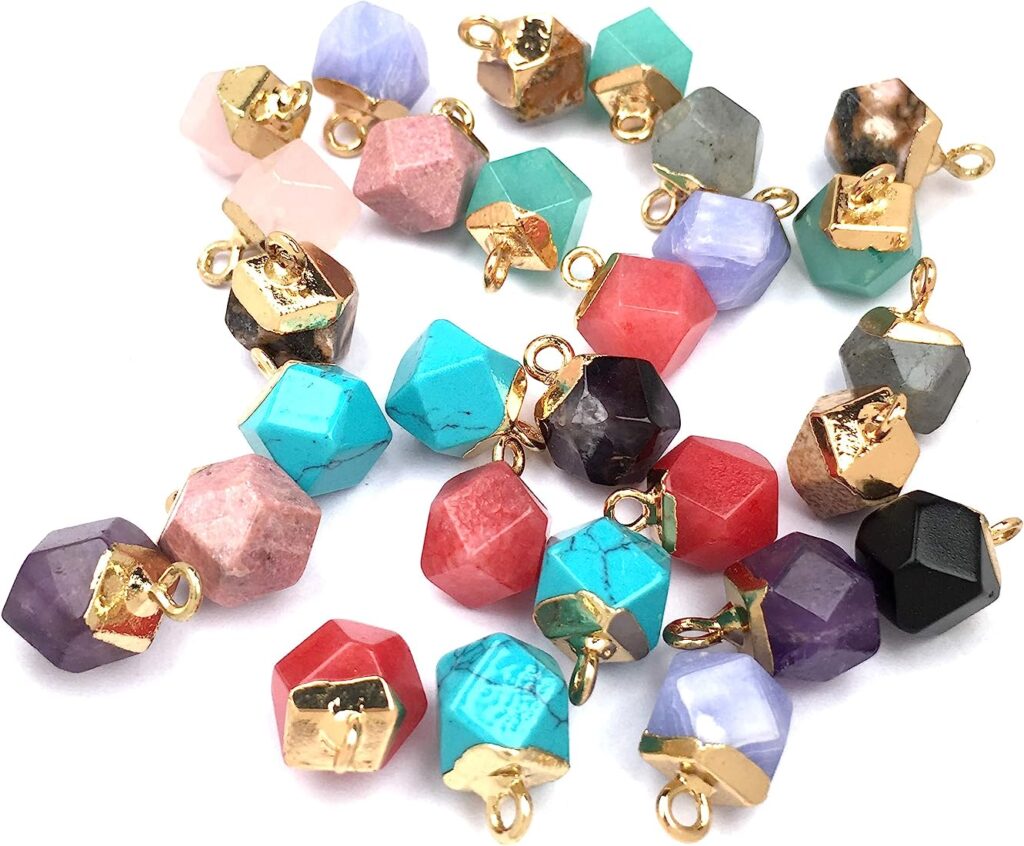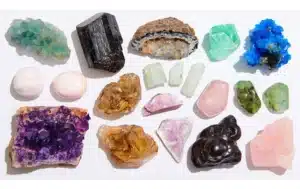In the mystical world of Feng Shui, stones and crystals have the ability to transform and balance energy. In this article, Phung Phuong will introduce you to one of these precious stones, Turquoise. Turquoise stone has a serene and peaceful color that seems to hold secrets of the ages. As a Feng Shui expert, I have discovered some hidden wisdom that this captivating stone holds, and I invite you to embark on a journey of discovery with me.
Honored in all cultures, Turquoise has long been regarded as a talisman for protection and abundance. However, there is much more to uncover about this mesmerizing gemstone. Found in the driest of places, where sacred waters flow beneath the surface, Turquoise possesses a unique essence that cannot be put into words. A true gift from Mother Nature, it was treasured by ancient civilizations and its allure continues to captivate us today.
With countless colors, patterns, and origins, each Turquoise stone whispers its own story, waiting for us to listen. Curious yet? Join LotusBuddhas and Feng Shui expert Phung Phuong to discover the answer to the allure of Turquoise stone. From its role in Feng Shui to its noteworthy spiritual properties, you will explore how this mesmerizing stone can elevate your life to new heights.
What is Turquoise stone?

The enchanting Turquoise stone, or as we in the Feng Shui community call it, the “Heavenly Skystone”. It is a semi-precious gemstone known for its unique blue to green hues. It is a hydrous phosphate of copper and aluminum, formed as a result of the weathering and oxidation of minerals in copper-rich areas. This stone has been highly valued and used for thousands of years across various civilizations, including the ancient Egyptians, Persians, and Native American cultures, for its beauty and spiritual properties.
The color of Turquoise can range from sky blue to greenish-blue or even green, depending on the presence of copper and iron impurities. The stone is often found with black, brown, or gray veins, called matrix, running through it, which can enhance its unique appearance.
Turquoise is believed to possess metaphysical properties and is often used in jewelry, amulets, and talismans. It is said to promote spiritual growth, protection, and good fortune, as well as bring balance and harmony to the wearer.
Turquoise stone is suitable for people who belong to the Wood element because the stone carries the Water element. Additionally, according to Western astrology, Turquoise is also a protective stone for those born in December, along with Tanzanite and Zircon.
Physical and chemical properties
| Properties | Description |
|---|---|
| Chemical Formula | CuAl6(PO4)4(OH)8·4H2O |
| Color | Varied shades of blue to green |
| Crystal System | Triclinic |
| Cleavage | Good in one direction |
| Fracture | Conchoidal to uneven |
| Luster | Waxy to sub-vitreous |
| Mohs Hardness | 5 – 6 |
| Specific Gravity | 2.6 – 2.8 |
| Transparency | Opaque |
| Streak | Bluish white |
| Refractive Index | ~1.61 – 1.65 |
| Birefringence | None |
| Optical Character | Usually aggregate; rarely weakly uniaxial negative |
| Fluorescence | None |
| Pleochroism | None |
| Solubility | Soluble in hot HCl; slightly soluble in cold HCl |
| Diaphaneity | Translucent to opaque |
| Luminescence | None to weak blue in long and short wave UV |
| Crystal Habit | Massive, nodular |
Please note that Turquoise is a hydrous phosphate of copper and aluminium, with the chemical formula CuAl6(PO4)4(OH)8·4H2O. It is rare and valuable in finer grades and has been prized as a gemstone and ornamental stone for thousands of years owing to its unique hue.
Where is the Turquoise stone found?

As I mentioned above, Turquoise often appears in arid regions with underground streams running through rocks near copper mines. Most Turquoise stones today come from Southwestern America and China. Each mining source has unique characteristics in terms of color and vein patterns inside the stone, creating the unique beauty of Turquoise.
- Southwestern United States: Particularly Arizona and New Mexico. These states are home to some of the most well-known turquoise mines. The stones from these areas often possess a distinct, rich blue color that’s highly prized.
- Nevada: Turquoise from Nevada is unique in its diversity of colors and matrix patterns, ranging from blues to greens and even some rare whites.
- Iran (Persia): Persian turquoise, historically renowned for its pure, robin’s egg blue color, has been mined in the region of Neyshabur for over 2000 years.
- China: Known for producing green and light blue turquoise, most of it is exported, particularly to the United States.
- Egypt: The world’s oldest known turquoise mines are located in the Sinai Peninsula. These mines have been exploited for thousands of years, initially by the Ancient Egyptians.
- Tibet: Tibetan turquoise, often green-blue with a heavy black matrix, is highly valued in the East for its spiritual significance.
- Mexico: Notably in the state of Sonora, turquoise exhibits bright, light blues with a high luster.
Each of these locations lends its own unique qualities to the turquoise it produces, making each stone a testament to the energies of its geographic origin.
Types of Turquoise stone

Turquoise is mined in many places around the world, and each location will give a name to the type of stone found in that area. This leads to the differentiation of various types of Turquoise based on their colors and patterns. Below are some notable types of Turquoise, each with their own distinct characteristics:
- Sleeping Beauty Turquoise: Mined in Arizona, USA, this highly sought-after Turquoise is known for its pure, robin’s egg blue color and minimal matrix. The Sleeping Beauty mine is now closed, which has increased the rarity and value of this type of Turquoise.
- Bisbee Turquoise: Also originating from Arizona, Bisbee Turquoise is prized for its deep blue color and unique chocolate brown to reddish-brown matrix. This Turquoise is considered rare, as the Bisbee mine is no longer producing Turquoise.
- Kingman Turquoise: Hailing from the Kingman mine in Arizona, this type of Turquoise exhibits a wide range of blue shades, from light to dark blue, often with black or silver-colored matrix patterns. Some Kingman Turquoise may also have a greenish tint.
- Persian Turquoise: Mined in Iran (historically known as Persia), Persian Turquoise is renowned for its pure, sky-blue color with little to no matrix. This type of Turquoise has been highly valued for centuries and is often considered a benchmark for Turquoise quality.
- Morenci Turquoise: Originating from the Morenci mine in Arizona, this Turquoise is known for its bright blue color and striking, irregular black or silver pyrite matrix patterns. Morenci Turquoise is also considered rare due to the limited availability of the stone.
- Chinese Turquoise: Found in various mines across China, Chinese Turquoise comes in a broad range of colors, from pale to deep green and sky blue to deep blue. The quality of Chinese Turquoise varies, and it may have a matrix with varying patterns and colors.
- Carico Lake Turquoise: Mined in Nevada, USA, Carico Lake Turquoise is known for its unique blue and green colors. The green Turquoise from this mine is particularly sought after, often featuring a golden-brown or reddish-brown matrix.
- Number 8 Turquoise: This rare type of Turquoise originates from the Number 8 mine in Nevada, which is now closed. It is characterized by its deep blue color and unique black, golden, or brown spiderweb matrix.
Meaning of Turquoise stone in Feng Shui

In Feng Shui, Turquoise carries the attributes and power of the Water element. Therefore, I often encourage my clients to use it to attract wealth and money. Furthermore, this stone is also applied in traditional Chinese medicine to improve the physical and mental health of the wearer.
With its soothing and mood-enhancing energy, Turquoise becomes an excellent decorative item for children’s rooms (especially teenagers), workplaces, or family living rooms.
In addition to the name “Skystone”, Turquoise is also affectionately called “Aqua Gem” by Feng Shui practitioners, believed to possess a unique ability to harmonize energy sources in space. Its celestial color narrows the gap between the earthly and spiritual realms, making it an ideal conduit for Qi or Chi (energy), which flows through everything.
The subtle power of the stone can be harnessed to arrange energy sources in the environment around a person, promoting prosperity, abundance, and tranquility. Those who have unlocked the secrets of the Aqua Gem can testify to its ability to dispel negative energies and attract positive vibrations.
Another little-known secret of Turquoise lies in its ability to promote open communication and strengthen relationships. The gentle blue color of Turquoise is believed to enhance the flow of the Throat Chakra, opening channels of expression and promoting trust between individuals.
The spiritual significance of Turquoise is truly amazing, isn’t it? But you should remember that to unlock the hidden potential of Turquoise, one must grasp the mysteries, decipher the secrets of the universe, and navigate the winding paths leading to Feng Shui enlightenment.
Uses of Turquoise stone

Due to its stunning color, Turquoise is used in various fields, including jewelry, spirituality, and healing methods. Below are some common uses of Turquoise stone that I have gathered from reliable sources such as TheSpruce and TinyRituals:
- Jewelry: Due to its unique color and beauty, Turquoise has been widely used in jewelry for thousands of years. It is often fashioned into necklaces, bracelets, earrings, and rings, making it a popular choice for personal adornment.
- Amulets and Talismans: Turquoise has long been regarded as a stone with protective and spiritual properties. Many cultures have used it as an amulet or talisman to ward off negative energies, provide protection during travel, and bring good luck.
- Chakra balancing: In alternative healing practices, Turquoise is believed to be associated with Throat Chakra. It is used to improve communication skills, enhance self-expression, and promote honesty in relationships.
- Spiritual growth: Turquoise is considered a powerful stone for spiritual growth and self-realization. Many people use it during meditation or energy work to strengthen their connection with higher consciousness and access inner wisdom.
- Emotional healing: Turquoise is also believed to help with emotional healing by balancing emotions, promoting inner peace, and alleviating stress and anxiety.
- Physical healing: Some alternative healers attribute various physical healing properties to Turquoise, such as strengthening the immune system, reducing inflammation, and supporting detoxification processes.
I will reveal to you how to use Turquoise stone to improve the health and happiness of your family. You can place the Turquoise stone in the eastern area of your home.
Remember to combine two necessary Feng Shui elements for this area – the Earth element (pale yellow and sand) with the Wood element (green and light brown) – to create more harmonious energy. According to the Five Elements theory – Water, Earth, and Wood will support each other to create a thriving and vibrant environment.
In addition, you can also place some shiny Turquoise stones in the bedroom to strongly support good sleep or a harmonious relationship, especially if your relationship is going through many challenges. Although Turquoise is highly valued for its beauty and spiritual properties, I also note that its healing abilities are based on beliefs and traditional practices, not on scientific evidence.
Benefits of wearing Turquoise stone

With its stunning colors and spiritual significance, Turquoise stone is used as a talisman. When carried, it emits vibrations that harmonize personal or environmental energies. This harmony can help dispel negative energies, enhance intuition, and bring balance to your life.
Some of my friends wear a pendant with a Turquoise stone to protect themselves from external negative energies. You can also wear a Turquoise bracelet or necklace to create a protective energy shield that repels negativity and promotes good health.
The true power of Turquoise lies in its ability to open the Throat Chakra and encourage honest communication. When you wear a Turquoise stone, you will find it easier to communicate with others, and your words will be heard and acknowledged.
For those seeking to strengthen their relationships with loved ones, Turquoise can serve as a tool for restoring relationships when worn. Its soothing and balancing energy encourages trust, empathy, and understanding, fostering healthier and more harmonious relationships.
Furthermore, many people believe that Turquoise also brings them more luck in life, with unexpected opportunities presenting themselves after wearing the stone. In summary, the benefits of wearing Turquoise are numerous, from balancing energies for improved health to enhancing communication and attracting good luck. This is why so many people love Turquoise.
How to care for your Turquoise stone
Turquoise has a hardness of 5-6 on the Mohs scale and is relatively brittle and susceptible to damage from heat or chemicals. The stone has an average water content of 18-20%, so I always advise jewelers to be extremely careful when working with it. For example, careless heating during gemstone processing can cause the water to evaporate gradually, and at a temperature of 400°C, the integrity of the mineral structure will be destroyed.
- Keep it clean: Gently clean your Turquoise with a soft, damp cloth, avoiding the use of harsh chemicals or abrasive materials. It’s important not to soak the stone, as its porous nature can cause it to absorb water and potentially weaken or discolor the stone.
- Avoid heat and sunlight: Prolonged exposure to direct sunlight or high temperatures can cause Turquoise to fade or change color. Store your stone in a cool, dry place away from direct sunlight and heat sources.
- Protect from scratches: Turquoise is a relatively soft stone, with a Mohs hardness of 5 to 6. To prevent scratches, store it separately from other harder gemstones, and consider using a soft pouch or jewelry box with individual compartments. Wipe clean with a damp cloth, then dry immediately, and Turquoise jewelry should be wiped with a damp cloth after use.
- Keep away from chemicals: Household chemicals, cosmetics, and perfumes can cause discoloration or damage to Turquoise. Remove your Turquoise jewelry before applying lotions, perfumes, or makeup, and avoid wearing it while cleaning or swimming in chlorinated water.
- Limit exposure to oils and perspiration: The porous nature of Turquoise makes it prone to absorbing oils and discoloring over time. Wipe your stone with a soft cloth after wearing it to remove any body oils or perspiration, and consider removing it during strenuous activities or exercise.
- Reapply any treatments if necessary: Some Turquoise stones are treated with stabilizing agents or color-enhancing treatments to improve their appearance. If your stone has been treated, consult a professional jeweler or gemologist to determine if and when any treatments should be reapplied.
Above are the experiences I have gained while working with my clients. By following these instructions, you can help preserve the beauty and integrity of your Turquoise stone, ensuring it remains a valuable possession for many years to come.
How to identify authentic Turquoise stone
In the world of gemstones, turquoise holds a unique place as a stone of protection, healing, and a conduit for accessing truth. Yet, it is unfortunate that many imitations of this magnificent stone abound in the market. Discerning genuine turquoise requires understanding its natural characteristics and a keen, mindful eye. Below are some key ways to identify authentic turquoise:
- Examine the Color: Real turquoise comes in hues from powdery blue to greenish-blue or even apple green, depending on the levels of copper (producing blue) and iron (producing green) it contains. If the color appears unnaturally bright or uniform, it may be a synthetic or dyed imitation.
- Observe the Matrix: The matrix, the web-like veins or patches of host rock that run through the stone, can be a tell-tale sign. Authentic turquoise often exhibits a complex, irregular matrix that’s hard to replicate synthetically.
- Look for Imperfections: Genuine turquoise is rarely perfect. It may have uneven coloration, varying textures, or small indentations. Imitations often appear too perfect or glossy.
- Check for Porosity: Real turquoise is porous and can change color over time due to absorption of skin oils or cosmetic products. Fakes, made from non-porous materials, won’t exhibit this behavior.
- Feel the Weight: Authentic turquoise has a distinct heft to it, feeling solid and substantial. Plastics or resins used for imitations will feel lighter.
- Consult a Gemologist or Experienced Jeweler: To be absolutely sure, have the stone examined by a professional who can perform tests to verify its authenticity.
True turquoise carries the energy of the heavens to Earth, serving as a spiritual balm to the heart. It is a stone that reflects the ancient wisdom of the Earth, bringing balance to the flow of Feng Shui energy in our lives. Therefore, it’s worth investing time to ensure the turquoise you acquire is authentically aligned with these powerful natural forces.
Combine Turquoise stone with other crystals
In the realm of crystal energies and Feng Shui, turquoise is a powerful healing stone, bringing the tranquility of water, the growth of wood, and the stability of earth into one’s energy field. But when combined with other crystals, the effect can be amplified, creating a powerful symphony of energies.
- Turquoise and Clear quartz: Clear Quartz, known as the ‘master healer’, amplifies the energies of other stones and intentions. Combined with turquoise, it enhances healing, clarity, and truth-seeking.
- Turquoise and Amethyst: Amethyst, a stone of spiritual growth and protection, pairs well with turquoise to enhance intuition, spiritual awareness, and self-discovery.
- Turquoise and Citrine quartz: Citrine, a stone of abundance and manifestation, can harmonize with turquoise to attract prosperity and success, while promoting generosity and sharing.
- Turquoise and Carnelian: Carnelian, a stone of motivation and endurance, combined with turquoise, can help overcome procrastination and take action, while maintaining emotional balance.
- Turquoise and Black Tourmaline: Black Tourmaline, known for grounding and protection, when used with turquoise, can provide a strong shield against negative energies while promoting inner calm.
- Turquoise and Rose quartz: Rose quartz, the stone of unconditional love, together with turquoise, can enhance compassion, forgiveness, and harmonious relationships.
Remember, when using crystals together, ensure that their energies resonate with your unique vibration and intention. Feng Shui is about harmonious interaction and balance; the right combination of crystals should create a sense of peace, harmony, and beneficial energy in your space and within your being. You might choose to wear these combinations as jewelry or place them in strategic locations in your home or workspace. Always cleanse and program your crystals with your intentions for the best results.
Is Turquoise a birthstone?
Turquoise is indeed a birthstone. Its calming energies and vibrant hue serve as a spiritual gift for those born in the month of December. As per the western, or traditional birthstone chart, Turquoise along with Blue Zircon and Tanzanite, are considered the birthstones for December. This has been recognized by the American Gem Trade Association.
In Feng Shui, Turquoise is associated with tranquil and healing energy, which can be a harmonious match for the introspective and often ambitious nature of December-born individuals. This stone’s energies bring good fortune, strength, and protection, particularly against negative forces. Moreover, Turquoise aids in truthful communication and higher wisdom, allowing the wearers to express themselves authentically and embrace their life journey with confidence.
Beyond the month of December, Turquoise can also be beneficial for all, especially when one seeks to balance the throat chakra, promote peaceful communication, enhance intuition, or provide protective energies. Just like water nourishes the earth, Turquoise energy can nourish the spirit, making it a beautiful and powerful stone to wear or keep in one’s environment, regardless of the month of one’s birth.
LotusBuddhas hopes that through the insights shared by feng shui expert Phung Phuong, you can gain a better understanding of Turquoise stone, its spiritual significance, and its uses in our daily lives.








